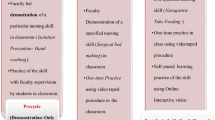Abstract
A video database of business–leader interviews has been implemented in the assignment work of students in a Bachelor of Business Administration program at a primarily-undergraduate liberal arts university. This action research study was designed to determine the most suitable assignment work to associate with the database in a Business Strategy course and to analyze how the nature of learning was impacted by this technology intervention. Three different assignment approaches to accessing the online database were considered with students. Based primarily on quantitative surveys and qualitative interviews and focus groups, the study determined that this sample of students (N = 65) preferred self-contained case study approaches that accessed regular interaction with the instructor and provided textual materials to supplement the database content.



Similar content being viewed by others
Explore related subjects
Discover the latest articles and news from researchers in related subjects, suggested using machine learning.References
Albanese, M., & Mitchell, S. (1993). Problem-based learning: a review of literature on its outcomes and implementation issues. Academic Medicine, 68(1), 52–81.
Auerbach, C. F., & Silverstein, L. B. (2003). Qualitative data: An introduction to coding and analysis. New York: New York University.
Barrows, H. (1985). How to design a problem-based curriculum for the pre-clinical years. New York: Springer Publishing.
Barrows, H. (1994). Practice-based learning: Problem-based learning applied to medical education. Springfield: Southern Illinois, University School of Medicine.
Brown, J., Collins, A., & Duguid, P. (1989). Situated cognition and the culture of learning. Educational Researcher, 18, 32–42.
Clark, R., & Mayer, R. (2011). E-learning and the science of instruction (3rd ed.). San Francisco: Pfeiffer.
Delisle, R. (2007). How to use problem-based learning in the classroom. Alexandria: ASCD.
Dewey, J. (1944). Democracy and education. New York: The Free Press.
Dunn, D., & Brooks, K. (2007). Teaching with cases. Halifax: Society for Teaching & Learning in Higher Education.
Friedland, S. (1996). How we teach: a survey of teaching techniques in American law schools. Seattle University Law Review, 20(1).
Goleman, D. (2000). Leadership that gets results. Harvard Business Review, March-April, 78–90.
Hambrick, D. (2001). Are you sure you have a strategy? The Academy of Management Executive, 15(4), 48–59.
Harrington, H. (1995). Fostering reasoned decisions: case-based pedagogy and the professional development of teachers. Teaching and Teacher Education, 11, 203–214.
Harvard. (2012). Multimedia case studies retrieved April 15th, 2012 from: http://hbsp.harvard.edu/multimedia/mm_cases/.
Kagan, D. (1993). Contexts for the use of classroom cases. American Educational Research Journal, 30, 703–723.
Krueger, R. (1994). Focus groups: A practical guide for applied research (2nd ed.). London: Sage.
Lincoln, Y., & Guba, E. (1985). Naturalistic inquiry. London: Sage.
Lundeberg, M., Levin, B., & Harrington, H. (1999). Who learns what from cases and how: The research base for teaching and learning from cases. Mahwah: Lawrence Erlbaum Associates.
MacKinnon, G. (2007). A decade of laptop computers: the impact on the pedagogy of university faculty. Journal of Instruction Delivery Systems, 21(3), 7–20.
MacKinnon, G., & Saklofske, J. (2011). Evaluating the pedagogical impact of a virtual world using concept mapping. Journal of Educational Multimedia and Hypermedia, 20(3), 267–281.
Maitland, B. (1997). Problem-based learning for architecture and construction management. In D. Boud & G. Feletti (Eds.), The challenge of problem-based learning. London: Kogan Page Ltd.
Marzano, R., Pickering, D., & Pollock, J. (2001). Classroom instruction that works. Alexandria: ASCD.
McLuhan, M., & Fiore, Q. (1967). The medium is the message. New York: Random House.
Naumes, W., & Naumes, M. (1999). The art and craft of case writing. Thousand Oaks: Sage.
Novak, J., & Gowin, D. (1984). Learning how to learn. New York: Cambridge University Press.
Parsons, R. D., & Brown, K. (2002). Teacher as reflective practitioner and action researcher. Belmont: Wadsworth-Thomson.
Patton, M. (2002). Qualitative research and evaluation (3rd ed.). Thousand Oaks: Sage.
Postman, N. (1993). Technopoly: The surrender of culture to technology. New York: Vantage Books.
Roblyer, M., & Schweir, R. (2003). Integrating educational technology into teaching. Toronto: Prentice Hall.
Selwyn, N. (2002). Telling tales on technology: Qualitative studies of technology and education. Burlington: Ashgate.
Spiro, R., Feltovich, P., Jacobsen, M., & Coulson, R. (1992). Cognitive flexibility, constructivism and hypertext: Random access instruction for advanced knowledge acquisition in ill-structured domains. In T. Duffy & D. Jonassen (Eds.), Constructivism and the technology of instruction. Hillsdale: Erlbaum.
Stinson, J., & Milter, R. (1996). Problem-based learning in business education: Curriculum design and implementation. In L. Wilkerson & W. Gijselaers (Eds.), Bringing problem-based learning to higher education: Theory and practice. New directions for teaching and learning (pp, Vol. 68, pp. 33–42). San Francisco: Jossey-Bass.
Tannen, D. (2006). Language and culture. In R. Fasold & J. Connor Linton (Eds.), Introduction to language and linguistics (pp. 343–372). Cambridge: Cambridge University Press.
Tippins, D., Koballa, T., & Payne, B. (2002). Learning from cases. Boston: Allyn & Bacon.
Weiss, R. (2003). Designing problems to promote higher-order thinking. New Directions for Teaching & Learning, 93, 25–31.
Wiggins, G., & McTighe, J. (1999). Understanding by design. Alexandria: Association for Supervision and Curriculum Development.
Author information
Authors and Affiliations
Corresponding author
Rights and permissions
About this article
Cite this article
MacKinnon, G., Vibert, C. Video databases: An emerging tool in business education. Educ Inf Technol 19, 87–101 (2014). https://doi.org/10.1007/s10639-012-9213-0
Published:
Issue Date:
DOI: https://doi.org/10.1007/s10639-012-9213-0




